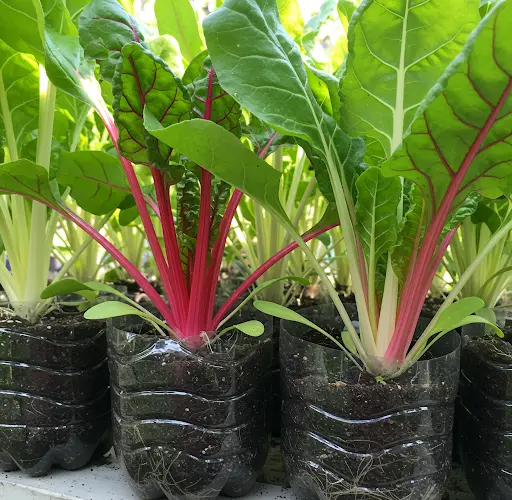How to Grow Swiss Chard in Plastic Bottles – A Smart Solution for Small Spaces
If you love leafy greens but lack space for a traditional garden, Swiss chard is the perfect plant to grow at home. This colorful, nutritious vegetable is not only easy to grow but also highly productive in small spaces. Even better, you don’t need fancy containers or a backyard – plastic bottles make excellent planters for growing Swiss chard.
By upcycling plastic bottles into mini containers, you can grow fresh greens on a balcony, windowsill, or wall-mounted vertical garden. It’s a practical, eco-friendly way to garden in urban areas and tight spaces.
Why Grow Swiss Chard?
Swiss chard is a leafy green that belongs to the same family as beets and spinach. It grows quickly, tolerates a range of temperatures, and produces over a long season. The leaves can be harvested young or allowed to grow large, and the colorful stems (ranging from white and yellow to red and pink) add visual appeal to your garden and plate.
Nutritionally, Swiss chard is packed with vitamins A, C, and K, as well as magnesium, potassium, and iron. It’s ideal for smoothies, salads, stir-fries, and soups.
Why Use Plastic Bottles?
Plastic bottles are widely available, lightweight, and easy to work with. Instead of throwing them away, you can repurpose them as containers for growing leafy greens. Using plastic bottles not only reduces waste but also provides a low-cost way to start gardening with minimal supplies.
They’re also highly versatile. You can:
-
Hang them vertically for a wall garden.
-
Attach them to railings or fences.
-
Line them up on a windowsill or balcony ledge.
-
Stack them creatively for a compact system.
What You’ll Need
To start growing Swiss chard in plastic bottles, gather the following:
-
Plastic bottles (1.5 to 2-liter size) – Choose ones with sturdy walls.
-
Potting mix – Use a well-draining, fertile mix enriched with compost or organic matter.
-
Swiss chard seeds or seedlings – Available in many varieties.
-
Sharp knife or scissors – To cut and modify the bottles.
-
Drill or nail – To make drainage holes.
-
Optional string or wire – For hanging or securing bottles.
How to Prepare the Bottles
-
Cutting the Bottle: Slice off the top third of the bottle or cut a rectangular window along the side, depending on whether you want to plant vertically or horizontally.
-
Drainage Holes: Poke small holes at the bottom of each bottle to allow excess water to escape. Proper drainage prevents root rot.
-
Positioning: If you plan to hang the bottles, make two holes near the top edge and thread string through them. You can also mount the bottles to a wooden frame or tie them along a railing.
Planting the Seeds or Seedlings
-
Fill with Soil: Add your potting mix up to about an inch below the rim of the bottle.
-
Planting: If using seeds, plant 2–3 per bottle, about ¼ to ½ inch deep. If transplanting seedlings, plant one per bottle.
-
Water Gently: Moisten the soil thoroughly without overwatering.
Place the bottles in a location that receives at least 4–6 hours of sunlight per day. Swiss chard grows well in partial sun but thrives in full sun, especially in cooler climates.
Caring for Swiss Chard
-
Watering: Keep the soil consistently moist. Bottles dry out faster than ground soil, so check daily, especially in warm weather.
-
Feeding: Add a diluted organic liquid fertilizer (like compost tea or fish emulsion) every 2–3 weeks to encourage lush leaf growth.
-
Pruning: Remove any yellowing leaves and thin the plants if they become overcrowded.
Swiss chard is fairly hardy and resists pests and diseases well, but keep an eye out for leaf miners and aphids. You can remove affected leaves and spray with a mild soap solution if needed.
Harvesting Your Swiss Chard
Swiss chard can be harvested multiple times. Start picking outer leaves when they’re about 6–8 inches long, leaving the inner ones to continue growing. This “cut-and-come-again” method ensures a continuous supply of greens over several months.
With good care, your plants will keep producing until the weather gets too hot or too cold, depending on your climate.
Advantages of Growing in Bottles
-
Space-saving: Ideal for balconies, windows, and small urban spaces.
-
Eco-friendly: Reuses plastic waste in a productive way.
-
Portable: Easy to move bottles to adjust sunlight exposure.
-
Inexpensive: Minimal cost for setup compared to commercial planters.
Final Thoughts
Growing Swiss chard in plastic bottles is a simple and sustainable gardening solution for anyone short on space but eager to grow fresh food. It’s beginner-friendly, highly productive, and perfect for urban dwellers who want to enjoy the benefits of homegrown greens. With a little time and creativity, you can turn everyday plastic waste into a vibrant, living garden – and enjoy healthy harvests for weeks to come.



